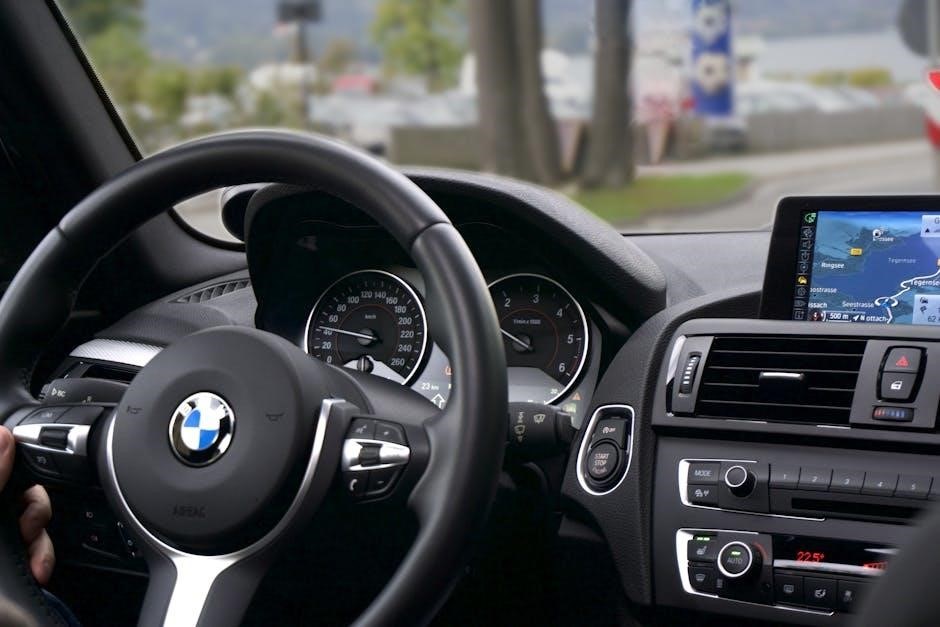BMW fault codes are diagnostic tools helping identify vehicle issues. They guide repairs and ensure optimal performance. A BMW fault codes PDF provides detailed explanations and troubleshooting steps.
1.1 Overview of BMW Diagnostic Codes
BMW diagnostic codes, also known as Diagnostic Trouble Codes (DTCs), are standardized codes used to identify specific issues within a vehicle’s systems. These codes are categorized into generic OBD-II codes (P-codes) and manufacturer-specific codes, which are unique to BMW. For example, codes like P213F (throttle position sensor fault) and P2140 (fuel pump system fault) are common issues that can be diagnosed using these codes. The BMW fault codes PDF provides a detailed list of these codes, their meanings, and related repair procedures. This guide is essential for technicians and enthusiasts alike, offering a comprehensive reference for troubleshooting and resolving engine, transmission, and fuel system faults efficiently.
1.2 Importance of Understanding Fault Codes
Understanding BMW fault codes is crucial for diagnosing and resolving vehicle issues promptly. These codes provide insights into system malfunctions, enabling precise repairs and preventing further damage. By referencing a BMW fault codes PDF, users can decode errors, identify faulty components, and address problems before they escalate. This knowledge helps in reducing repair costs and ensures safety by preventing sudden system failures. Additionally, understanding fault codes empowers drivers to communicate effectively with technicians, ensuring accurate diagnoses and efficient solutions. Regular monitoring of these codes can also aid in maintaining optimal vehicle performance and longevity. A BMW fault codes PDF serves as an essential resource for both DIY enthusiasts and professionals.
1.3 Purpose of BMW Fault Codes PDF
The BMW fault codes PDF is designed to provide a comprehensive guide for understanding and interpreting diagnostic trouble codes (DTCs). It serves as a valuable resource for technicians and car enthusiasts, offering detailed explanations of each code, associated symptoms, and potential causes. This document helps streamline the diagnostic process, ensuring accurate repairs and minimizing downtime. By referencing the PDF, users can identify specific issues related to systems like fuel injection, transmission, and engine control. It also includes troubleshooting steps and repair procedures, making it an indispensable tool for maintaining BMW vehicles efficiently. The PDF is regularly updated to cover a wide range of models and systems, ensuring relevance and applicability.

Types of BMW Fault Codes
BMW fault codes include P-codes, DTCs, fuel injection, and transmission codes, each providing specific diagnostic insights for accurate vehicle repairs and maintenance purposes.
2.1 Generic OBD-II Codes (P-Codes)
Generic OBD-II codes, or P-codes, are standardized diagnostic trouble codes used across various vehicle manufacturers, including BMW. These codes are designed to provide a uniform method for identifying and diagnosing issues within a vehicle’s engine, transmission, emissions, and other critical systems. P-codes are typically retrieved using an OBD-II scanner, which connects to the vehicle’s onboard diagnostics system. Once a P-code is retrieved, it can be referenced in a BMW fault codes PDF or other diagnostic manuals to understand the specific issue. For example, common P-codes like P213F (throttle position sensor fault) and P2140 (fuel pump system fault) are widely recognized and addressed across different vehicle makes. These codes are invaluable for technicians and DIY enthusiasts alike, offering a clear starting point for troubleshooting and repairs. By standardizing these codes, OBD-II ensures consistency and ease of use, making it easier to identify and resolve problems efficiently. This universal approach simplifies the diagnostic process, allowing for quicker and more accurate fixes, which is essential for maintaining vehicle performance and longevity.
2.2 Manufacturer-Specific Codes (BMW DTCs)
BMW DTCs (Diagnostic Trouble Codes) are manufacturer-specific codes that provide detailed information about faults in BMW vehicles. Unlike generic OBD-II codes, these codes are tailored to BMW’s unique systems and components. They often relate to advanced systems like the DME (Digital Motor Electronics), DDE (Digital Diesel Electronics), and EML (Electronic Monitoring System). BMW DTCs offer precise diagnostics for issues specific to BMW models, such as engine control modules, transmission systems, and advanced driver-assistance technologies. These codes are typically accessed using BMW-specific diagnostic tools like INPA or EDIABAS. A BMW fault codes PDF guide is essential for interpreting these codes, as they require specialized knowledge to understand and resolve. These codes ensure accurate troubleshooting and repairs, making them indispensable for technicians and enthusiasts working on BMW vehicles.
2.3 Fuel Injection System Fault Codes
Fuel injection system fault codes in BMW vehicles are specific to issues within the fuel delivery system. These codes often indicate problems with fuel pumps, fuel injectors, or fuel pressure sensors. Common codes like P2140 signify fuel pump system faults, while others may point to injector circuit malfunctions. These codes are critical for diagnosing issues that affect engine performance, fuel efficiency, and emissions. A BMW fault codes PDF guide provides detailed explanations, helping technicians identify faulty components and perform necessary repairs. Addressing these codes promptly prevents further damage and ensures optimal engine operation. Regular monitoring of these codes is essential for maintaining vehicle health and performance.
2.4 Transmission and Throttle System Codes
Transmission and throttle system codes in BMW vehicles are crucial for diagnosing issues related to gear shifts and pedal response. Codes like P213F indicate throttle position sensor malfunctions, affecting engine performance and acceleration. These codes often highlight problems with sensors, wiring, or mechanical components. A BMW fault codes PDF guide provides detailed insights, enabling technicians to pinpoint issues efficiently. Addressing these codes is vital for restoring smooth transmission operation and proper throttle response. Ignoring these faults can lead to reduced vehicle performance and safety risks. Regular checks and timely repairs ensure optimal driving experiences and prevent costly damages over time.

Tools for Accessing BMW Fault Codes
OBD-II scanners and BMW-specific tools like INPA and EDIABAS are essential for accessing fault codes. Software aids in code retrieval, and a BMW fault codes PDF guide enhances diagnostics.
3.1 OBD-II Scanners
OBD-II scanners are universal tools for accessing BMW fault codes. They support standard P-codes retrieval, making them compatible with most BMW models. These scanners connect to the vehicle’s OBD-II port, providing real-time data on engine performance and stored codes. Many modern OBD-II scanners feature Bluetooth or Wi-Fi connectivity, enabling smartphone app integration for enhanced convenience. While they are effective for generic diagnostics, they may not cover manufacturer-specific codes, which require specialized BMW tools. OBD-II scanners are widely available and user-friendly, making them a popular choice for DIY enthusiasts and professionals alike. They are an essential first step in identifying issues.
3.2 BMW-Specific Diagnostic Tools (e.g., INPA, EDIABAS)
BMW-specific diagnostic tools like INPA and EDIABAS are essential for accessing detailed fault codes and performing advanced diagnostics. These tools are tailored for BMW systems, offering deeper insights than generic OBD-II scanners. INPA allows real-time monitoring of engine parameters, activation of components, and retrieval of manufacturer-specific codes. EDIABAS provides advanced functionality, including fault code analysis and special service functions. These tools are particularly useful for diagnosing issues related to the DME, DDE, and EML systems. They often require a laptop and BMW-specific software, making them more technical but highly effective for precise troubleshooting. Resources like the BMW Super Fault Codes PDF and repair manuals complement these tools for comprehensive diagnostics.
3.3 Software for Code Retrieval
Software for code retrieval plays a crucial role in diagnosing BMW faults. Tools like INPA, EDIABAS, and specialized OBD-II software enable users to access detailed diagnostic trouble codes (DTCs). These programs often connect to BMW-specific hardware interfaces, providing real-time data and fault code analysis. Many software solutions allow users to view live engine parameters, perform component tests, and even clear codes after repairs. Additionally, resources like the BMW Fault Codes PDF guide complement these tools by offering explanations of specific codes and repair procedures. This combination of software and reference materials is essential for effective troubleshooting and ensures accurate diagnosis of vehicle issues. Advanced features may include logging capabilities and system updates for enhanced functionality.

Common BMW Fault Codes
BMW vehicles often display specific fault codes like P213F (throttle sensor issues) and P2140 (fuel pump faults). These codes indicate system malfunctions, guiding repairs effectively.
4.1 P213F: Throttle/Pedal Position Sensor/Switch E Fault
P213F indicates a fault in the throttle or pedal position sensor/switch. This code is triggered when the ECM detects an abnormal signal from the sensor. Common causes include faulty wiring, corrosion, or sensor failure. Symptoms may include erratic throttle response, reduced engine power, or stalling. Diagnosing P213F involves checking the sensor’s electrical circuit and testing its output. Replacement of the faulty component is typically required to resolve the issue. Referencing a BMW fault codes PDF can provide detailed repair procedures and troubleshooting steps for this specific DTC.
4.2 P2140: Fuel Pump System Fault
P2140 indicates a fuel pump system fault, often leading to forced engine shutdown. This code is triggered when the ECM detects irregular fuel pressure or flow. Common causes include a faulty fuel pump, wiring issues, or a malfunctioning fuel pressure sensor. Symptoms may include poor engine performance, rough idling, or difficulty starting the engine. Diagnosing P2140 involves checking the fuel pump, its circuit, and related sensors. Consult a BMW fault codes PDF for detailed troubleshooting steps and repair procedures. Addressing this issue promptly is crucial to prevent further engine damage and ensure reliable vehicle operation.
4.3 Knock Sensor Circuit Codes
Knock sensor circuit codes relate to issues with engine knock detection. These codes, such as P0332 or P0327, indicate problems in the knock sensor’s circuit or its connection. The knock sensor monitors engine vibrations to prevent damage from detonation. Faults may stem from a faulty sensor, wiring damage, or poor connections. Symptoms include reduced engine performance and efficiency. A BMW fault codes PDF guide provides detailed diagnostic steps, such as testing sensor resistance and checking wiring. Addressing these issues ensures proper engine operation and prevents potential damage. Regular maintenance and inspections are key to avoiding knock sensor-related problems.
4.4 Forced Engine Shutdown Codes
Forced engine shutdown codes indicate severe issues that require immediate attention to prevent damage. These codes, such as those related to fuel system faults or ignition misfires, trigger the engine to shut down to avoid further harm. The BMW fault codes PDF guide provides detailed explanations of each code, helping technicians identify faulty components like sensors or fuel injectors. It also outlines repair procedures, ensuring the issues are resolved efficiently. Regular diagnostics using this guide can prevent unexpected shutdowns, maintaining vehicle performance and longevity.

Interpreting BMW Fault Codes
BMW fault codes are structured to help technicians quickly identify issues. The PDF guide provides detailed explanations, enabling precise diagnostics and effective repairs for optimal vehicle performance.
5.1 Structure of Diagnostic Trouble Codes (DTCs)
BMW fault codes, or DTCs, follow a standardized structure to help technicians quickly identify issues. Codes typically start with a letter indicating the system (e.g., P for powertrain) and are followed by numbers specifying the fault. For example, P213F refers to a throttle position sensor issue. The BMW fault codes PDF provides detailed breakdowns, explaining each code’s meaning and related components. This structure ensures precise diagnostics, enabling mechanics to locate and address problems efficiently. By understanding the code format, technicians can pinpoint faulty sensors, circuits, or systems, streamlining the repair process and ensuring accurate resolutions.
5.2 Cross-Referencing Codes with BMW Manuals
Cross-referencing BMW fault codes with official manuals ensures accurate diagnostics. The BMW fault codes PDF often aligns with factory manuals, providing detailed explanations and repair procedures. For instance, codes like P213F and P2140 are linked to specific systems, such as throttle sensors or fuel pumps. By referencing these codes in BMW manuals, technicians can identify the faulty component, understand the affected circuit, and follow validated repair steps. This process minimizes guesswork and ensures compliance with manufacturer guidelines. Additionally, resources like the Bentley repair manual offer comprehensive cross-references, aiding in precise troubleshooting and efficient resolution of issues. This method is crucial for maintaining vehicle performance and reliability.
5.3 Using the BMW Fault Codes PDF Guide
The BMW fault codes PDF guide is an essential resource for diagnosing and resolving vehicle issues. It provides a comprehensive list of codes, their meanings, and related systems. For example, codes like P213F and P2140 are linked to throttle sensors and fuel pump faults, respectively. The guide includes step-by-step repair procedures, wiring diagrams, and troubleshooting tips. Technicians can cross-reference codes with detailed descriptions to identify faulty components and circuits. Regular updates ensure the guide stays current with new models and systems. By using the BMW fault codes PDF, users can efficiently address problems, minimizing downtime and ensuring accurate repairs. It is a vital tool for both professionals and enthusiasts.

OBD-II and BMW Vehicles
OBD-II systems in BMW vehicles enable standardized diagnostics. The BMW fault codes PDF guide helps interpret OBD-II codes, facilitating code retrieval and management for efficient troubleshooting and repairs.
6.1 OBD-II Compatibility in BMW Models
Bmw models from 1996 onwards are equipped with OBD-II systems, ensuring compatibility with generic and BMW-specific diagnostic tools. This standardization allows for uniform fault code retrieval across vehicles. The OBD-II system in BMWs provides real-time data and stored trouble codes, aiding in efficient diagnostics. By using an OBD-II scanner, owners and technicians can access codes, monitor engine performance, and troubleshoot issues effectively. Compatibility varies slightly across different BMW series, but most modern models support advanced OBD-II features, making diagnostics more accessible and streamlined.
6.2 Reading OBD-II Codes in BMW
Reading OBD-II codes in BMW vehicles involves connecting an OBD-II scanner to the vehicle’s OBD-II port, typically located under the dashboard. Turn the ignition on, then use the scanner to retrieve stored or real-time fault codes. Generic OBD-II scanners can access standard codes, while BMW-specific tools like INPA may be required for manufacturer-specific codes. The process provides detailed information about engine performance and identifies issues such as fuel system faults or sensor malfunctions. Referencing a BMW fault codes PDF guide helps interpret the codes accurately, ensuring proper diagnosis and repair of the vehicle’s systems.
6.3 Erasing Fault Codes
Erasing fault codes in BMW vehicles is essential after repairs to ensure the system clears stored issues. Using an OBD-II scanner or BMW-specific diagnostic tools like INPA, connect to the vehicle’s OBD-II port and navigate to the erase function. Turn the ignition on with the engine off, then follow the tool’s prompts to clear the codes. Some systems may require a key cycle or specific button presses. After erasing, test drive the vehicle to confirm the issues are resolved. Always refer to a BMW fault codes PDF guide for detailed instructions and ensure no new codes reappear, indicating successful repairs. Proper erasure prevents misleading diagnostics and ensures accurate monitoring of the vehicle’s health.

Manufacturer-Specific Codes
BMW-specific codes provide detailed diagnostics beyond generic OBD-II codes, offering precise fault identification for systems like DME, DDE, and Motronic engine control.
7.1 BMW DME/DDE Diagnostic Codes
BMW DME (Digital Motor Electronics) and DDE (Digital Diesel Electronics) codes are specific to engine control systems. These codes help diagnose issues like fuel injection, ignition timing, and sensor malfunctions. For instance, codes related to the throttle position sensor or fuel pump system provide precise fault locations. The BMW fault codes PDF guides detail these codes, enabling technicians to identify faulty components efficiently. By referencing these codes, repairs can be targeted, reducing diagnostic time and ensuring accurate fixes. This section focuses on interpreting DME/DDE codes to address engine-related problems effectively.
7.2 EML and DDE System Faults
EML (Electronic Monitoring System) and DDE (Digital Diesel Electronics) faults are critical for diagnosing engine performance issues. These codes pinpoint problems in fuel injection, emissions, and sensor operations. For example, faults in the EML system may indicate issues with exhaust gas recirculation or oxygen sensor circuits. The BMW fault codes PDF provides detailed explanations of EML and DDE codes, enabling technicians to identify malfunctions accurately. By cross-referencing these codes with repair manuals, professionals can address system failures efficiently. This section focuses on understanding EML and DDE-specific codes to resolve engine-related problems effectively.
7.3 Motronic Engine Control System Codes
Motronic engine control system codes are specific to BMW’s advanced engine management technology. These codes help diagnose issues like throttle position sensor faults (e.g., P213F) and fuel pump system malfunctions (e.g., P2140). The Motronic system integrates fuel injection, ignition timing, and emissions control, making it crucial for engine performance. Fault codes in this system often relate to sensor circuit problems or fuel delivery issues. A BMW fault codes PDF guide provides detailed explanations of Motronic-specific codes, enabling technicians to pinpoint malfunctions. By referencing these codes, professionals can perform precise repairs, ensuring the engine operates efficiently and maintains optimal performance.

BMW Fault Codes PDF Resources
BMW fault codes PDF resources offer comprehensive lists and guides for diagnosing issues. These include detailed DTC codes, Bentley manual references, and specialized troubleshooting documents.
8.1 BMW DTC Codes List PDF
The BMW DTC Codes List PDF provides a detailed compilation of diagnostic trouble codes specific to BMW vehicles. This resource includes generic OBD-II codes and manufacturer-specific codes, ensuring comprehensive coverage for various systems such as engine, transmission, and fuel injection. Each code is accompanied by descriptions and troubleshooting steps, making it an essential tool for mechanics and enthusiasts alike. By referencing this guide, users can quickly identify faults and understand the necessary repairs, streamlining the diagnostic process and reducing downtime. The PDF format allows for easy access and reference on various devices.
8.2 Bentley Repair Manual References
Bentley repair manuals are highly regarded for their detailed coverage of BMW systems and fault codes. These manuals provide in-depth repair procedures, wiring diagrams, and component locations, making them invaluable for diagnosing and resolving issues. Bentley references often include cross-references to specific fault codes, allowing technicians to pinpoint problems efficiently. They cover a wide range of models and systems, including engine, transmission, and electronic controls. By aligning with BMW fault codes PDF resources, Bentley manuals offer a comprehensive solution for troubleshooting and repair. Professionals and enthusiasts alike rely on these manuals for accurate and detailed technical information.
8.3 Comprehensive Fault Code Guides
Comprehensive fault code guides provide detailed insights into BMW diagnostic codes, covering a wide range of models and systems. These guides include engine, transmission, and emissions codes, as well as those related to advanced electronic systems. They are designed to assist both professional technicians and DIY enthusiasts in troubleshooting and repairing issues. By offering step-by-step diagnostic procedures and repair tips, these guides simplify the process of identifying and resolving faults. Many guides also include explanations of code structures and their corresponding symptoms, making them invaluable for understanding complex systems. Available in PDF formats, they often align with OBD-II standards and manufacturer-specific codes, ensuring comprehensive coverage.

Troubleshooting with Fault Codes
Troubleshooting with BMW fault codes involves identifying faulty components and resolving issues using diagnostic tools. Codes guide technicians to specific problems, enabling targeted repairs and system resets.
9.1 Identifying Faulty Components
Identifying faulty components using BMW fault codes begins with retrieving codes via diagnostic tools. Each code corresponds to specific issues, such as faulty sensors or system malfunctions. By referencing a BMW fault codes PDF, technicians can pinpoint the exact component related to the code. For example, P213F indicates a throttle position sensor issue, while P2140 points to a fuel pump system fault. This precise identification streamlines repairs, reducing diagnostic time. The PDF guide provides detailed descriptions, ensuring accurate troubleshooting and efficient resolution of vehicle problems. This systematic approach minimizes guesswork, leading to effective and reliable repairs.
9.2 Repair Procedures Based on Codes
Repair procedures based on BMW fault codes are systematically outlined in the BMW fault codes PDF; Once a code is identified, the guide provides step-by-step instructions tailored to the specific issue. For instance, a P213F code may require cleaning or replacing the throttle position sensor, while P2140 could involve checking fuel pump circuitry or replacing the pump itself. The PDF often includes diagrams and troubleshooting tips, ensuring repairs are conducted accurately. By following these procedures, technicians can address the root cause efficiently, restoring vehicle performance and preventing recurring issues. This structured approach ensures reliability and minimizes downtime for both professionals and DIY enthusiasts.
9.3 Resetting Codes After Repair
After completing repairs, resetting fault codes is crucial to ensure the system clears the error. The BMW fault codes PDF provides detailed instructions for this process. Using an OBD-II scanner or BMW-specific tools like INPA, technicians can erase codes from the ECU memory. It’s important to follow proper procedures to avoid incomplete resets, which may lead to recurring issues. The PDF guide often includes step-by-step instructions, such as turning the ignition on with the engine off or using specialized software. Resetting codes allows the vehicle to operate normally and verifies if the repair was successful. This step ensures accurate system functionality and prevents false error notifications.

Advanced Diagnostics
Advanced diagnostics involve specialized tools and techniques to deeply analyze BMW systems. Component activation tests and status requests help pinpoint issues beyond basic fault code readings.
10.1 Component Activation Tests
Component activation tests are advanced diagnostic procedures used to evaluate the functionality of specific vehicle components. These tests simulate real-world operating conditions to identify faults not apparent during standard scans. By activating components like fuel pumps or solenoids, technicians can observe performance in real-time. This method is particularly useful for diagnosing intermittent issues. Using tools like INPA or EDIABAS, technicians can trigger component activation, monitor responses, and cross-reference findings with BMW fault codes PDF guides. Such tests ensure precise fault identification, enabling targeted repairs and reducing diagnostic time. They are essential for complex systems, such as engine control modules or transmission systems.
10.2 Status Requests and Special Functions
Status requests and special functions are critical for advanced diagnostics, offering detailed insights into system operations. These features enable technicians to retrieve real-time data, such as sensor readings or actuator statuses. Special functions allow control over specific components, aiding in precise fault isolation. For instance, activating a fuel pump or testing emission control systems can replicate conditions causing faults. BMW fault codes PDF guides often outline procedures for executing these tests. By leveraging these tools, technicians can verify repairs and ensure systems function correctly. Status requests also help monitor vehicle performance post-repair, ensuring issues are fully resolved and preventing future problems. This enhances diagnostic accuracy and efficiency, making it indispensable for skilled technicians.
10.3 Using Diagnostic Tools for Advanced Troubleshooting
Advanced diagnostic tools are essential for effectively troubleshooting BMW systems. These tools enable detailed analysis of complex issues, often beyond basic fault code retrieval. BMW-specific tools like INPA and EDIABAS provide access to real-time data, component activation, and adaptive learning functions. They allow technicians to simulate conditions, test sensors, and reset systems. Additionally, software solutions can interpret fault codes and provide repair guidance. By integrating these tools with a BMW fault codes PDF, technicians can pinpoint issues efficiently. Real-time monitoring and advanced testing capabilities ensure accurate diagnoses, reducing repair time and improving outcomes. These tools are vital for addressing modern vehicle complexities and ensuring optimal performance.
